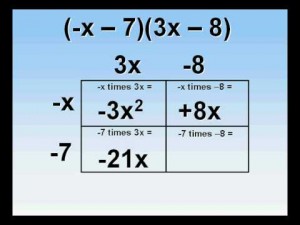As teachers or even future teachers, we want out students to succeed, which is simply an understatement. However, by the time our students reach the point of factoring polynomials it seems that our job has multiplied in difficulty. This is because there are many different issues arising. If a student struggles with a previous topic it is magnified when it comes time to learn about multiplying binomials. For example, the common term FOIL was created to help student understand that during the multiplication of binomials there is that pesky middle term everyone wish was not there. Or even the Freshmen’s Dream of (A+B)^2 = A^2 + B^2, which in reality is not correct. Thus, I have created a learning progression to help iron out some of the common problems and a game plan for helping student factor quadratics at a balanced and progressive pace, offering much needed time for practice.
This learning progression will be taught in a 10th grade High School Algebra classroom and the following two Common Core State Standards will be used as goals: HSA.SSE.B.3 and HAS.SSE.B.3.a. Additionally, the mathematical practices that align with this learning progression are the following: MP1 Make sense of problems and persevere in solving them, MP5 Use appropriate tools strategically, and MP6 Attend to precision. The textbook this class uses is CORD Algebra 1 Learning in Context 4th edition. Specifically, I will be using chapter 7 on polynomial and factors.
Students have previously been introduced to and worked with linear and quadratic functions. Specifically, with linear functions they have practiced finding roots/x-intercepts and y-intercepts. In this learning progression students will be once again looking at roots, but of quadratic functions. The first skill and portion of this lesson will be to examine how to manipulate a function into a factored form so as to reveal information about the function itself. Then, next step will be to have students practice this process with a variety of functions having various leading coefficients, making sure that all given functions can be factored into binomials evenly. The third lesson in this progression will be to consider cases where the function cannot be factored into binomial terms that are easily found through guess and check, factor fish, factoring using factors of the first and last coefficients, or some other method. Thus, with the third lesson the quadratic formula will be introduced. All of these lessons will focus on finding roots and the meaning behind the zeros.
To help students gain the most from this learning progression two additional methods of instruction besides lecture and question/answer discussions will be incorporated into the lessons. The first will be using groups to help students support their own understanding and those of others. According to the study done by Gulfer Capar and Kamuran Tarim in 2015, having students work in groups provides a greater increase of student understanding and achievement and thus helps support the current theory of cooperative learning in connection with mathematics. Since student will be working and collaborating together on the mathematics, student who normally struggle in this subject area will have immediate supported, setting students at ease and allowing for focus to be on the material. The second added method will be using games to help strengthen understanding and recall skills. A study conducted at Michigan State University by James Banfield and Brad Wilkerson in 2014 found that there was an increase in student understanding and skills with the material when the instructor used games to help teach the lessons. Thus, during my learning progression I will also include time to practice the material through the use of a game.
